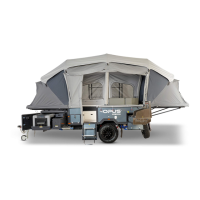10 11
WHEELS, BRAKES & TIRES ABOUT YOUR HITCH
LOCK’N’ROLL HITCH
The OP4 comes as standard with a Lock’n’Roll arculang hitch. The hitch allows for pivong on 3 axis and provides an overall
smoother towing experience. Ensure the locking pin is fully inserted and secured in place before towing. When hitching the OPUS®
to your towing vehicle you must ensure that someone is close to the handbrake in order to maintain control of the trailer, parcular-
ly when unhitching on uneven ground or a slope. The Lock’n’roll hitch is a two-part hitch with a vehicle-side and a driver side part.
• The vehicle side ts in a 2’’ hitch receiver and should be locked in place with an appropriate hitch receiver lock.
• The trailer side is already installed on your OP4.
• To connect the two parts, the trailer side pin arms should be placed in the receiving secon on the vehicle side part.
• The hook arms then t over the trailer-side pin arms and a securing pin is ed through the holes in the hook arms and the hole in
the main receiving secon on the vehicle side part.
• This will hold the trailer side pin arms in place.
• Use a locking pin on the securing pin to fully lock the coupling in place.
TRAILER SIDE PIN ARMS
TRAILER-SIDE HITCH PART VEHICLE-SIDE HITCH PART
CORRECT HITCH COUPLING POSITION FOR TRAVEL
FITS 2 INCH RECEIVER
HOOK ARM
SECURING PIN
LOCKING PIN
Hook arms t over trailer-side pin arms. NOTE securing pin through holes in hook arms and locking pin to hold it in place
WHEELS & TIRES
Torque all wheel bolts to 100 lbs. When ghtening wheel nut lugs, please ghten bolts in a star-paern order as indicated
in the diagram in the Care & Maintenance secon of this manual.
ABOUT YOUR ELECTRICAL PLUG
The OPUS® is ed with a 7-pin at plug that connects all the exterior trailer running/break/turn
lights and the electric brakes to the towing vehicle. You will require a 7-pin connecon on your
tow-vehicle as well as an in-car electric break controller installed in your tow vehicle to operate
them.
ABOUT YOUR BRAKES
The OPUS® is ed with electric trailer brakes. You need an electric brake controller ed to your car in
order to tow the OPUS® and operate the electric breaks safely. Failure to tow with a brake controller
in your vehicle is both dangerous and illegal. You can tell if your brakes are working properly by
connecng the 7-pin plug, starng the engine of the tow vehicle and then geng someone to listen
to the brake hub whilst another person applies the brakes in the tow vehicle. If they are working
correctly you will here a low humming sound as the brakes are applied.
BRAKE MAINTENANCE
As part of the annual service check that you should have completed by an accredited industry service
agent, the brakes must be checked and maintained.
INSTALLING YOUR SAFETY CHAINS
The OPUS® is ed with 2 safety chains on the tongue. One end of the chain is ed to the OPUS®
chassis and the other end has an aachment clip which should be aached securely to your tow
vehicle bumper or receiver.
TOWING
The driver of the tow vehicle must ensure that their Driver’s License is valid for towing the OPUS® Camper. It is highly
recommended, parcularly if you are not experienced in towing, that you adhere to any applicable laws for the state in
which you are driving. Many guides are available from leading associaons and should be studied before you embark. Trailer
towing laws are dierent in each state. Please be aware If you are traveling across mulple states that you could suddenly be
breaking tow laws if you’re not careful. States dier on their rules about mulple trailers. If you’re hauling a camper and a Jet
Ski behind it, you’d be OK in South Carolina, but breaking the law once you cross the Georgia state line. No maer where you
are in the U.S., the following features are recommended safety equipment for trailer towing:
* Lights: Your trailer lights must be maintained in working order for basic road safety.
* License plate light: Make sure to clearly display your license plate
* Reectors: These are an invaluable precauon to keep your large trailer visible.
* Flares: Keep these at hand to clear o a secon of the road aer an accident.
* Tie-downs: If you are loading anything on a trailer that could possibly fall o, you’ll need e-downs to secure it at
mulple angles.
• Ensure the clips on the hooks are in place to fully secure the hooks.
• Do not aach the hooks to the hitch itself.
• Ensure that you have enough slack in the chains to turn your vehicle adequately.
• Should you require less slack, the chains can be twisted or crossed below the tongue before
connecng to your vehicle to ensure the chains do not drag on the ground.

